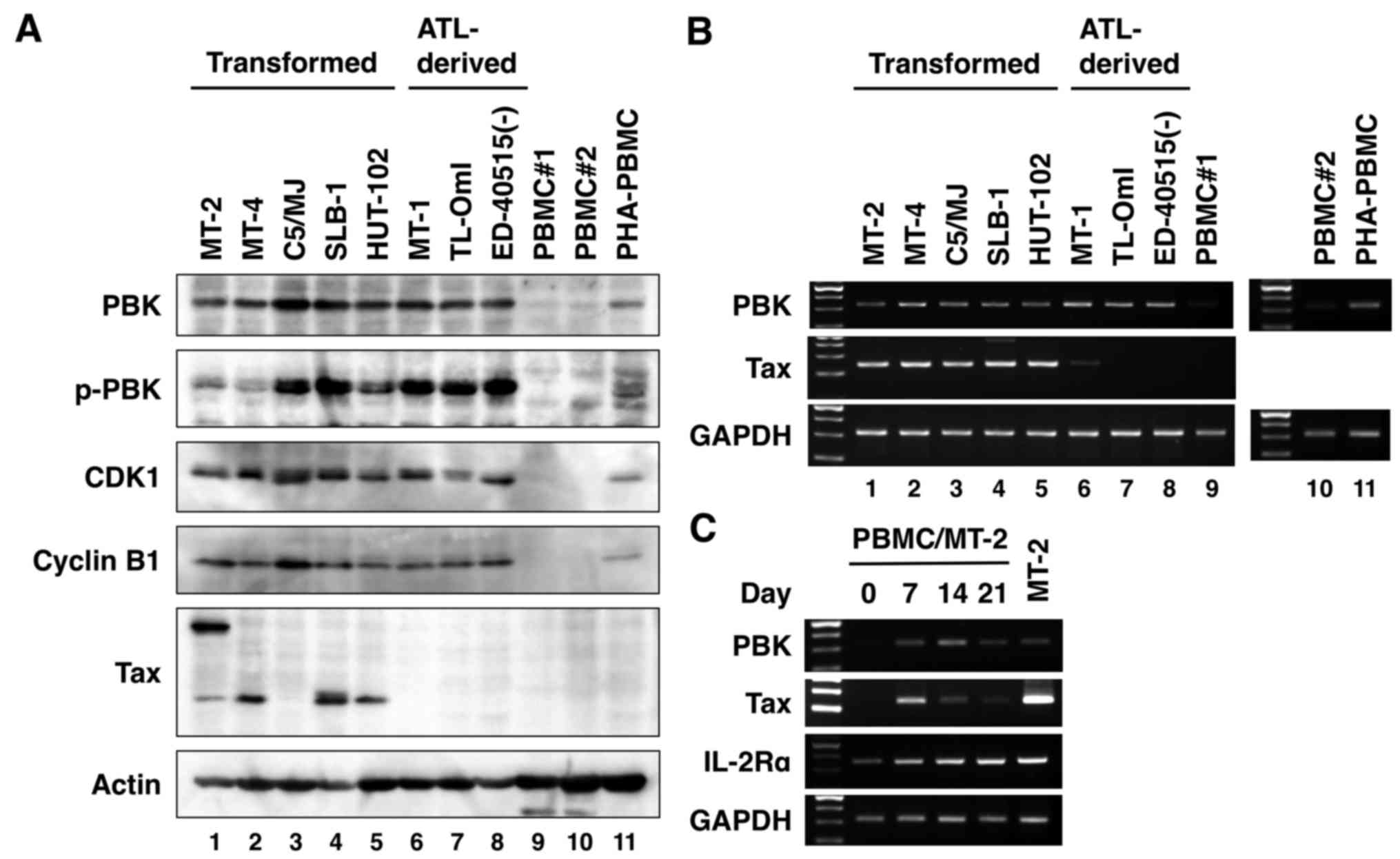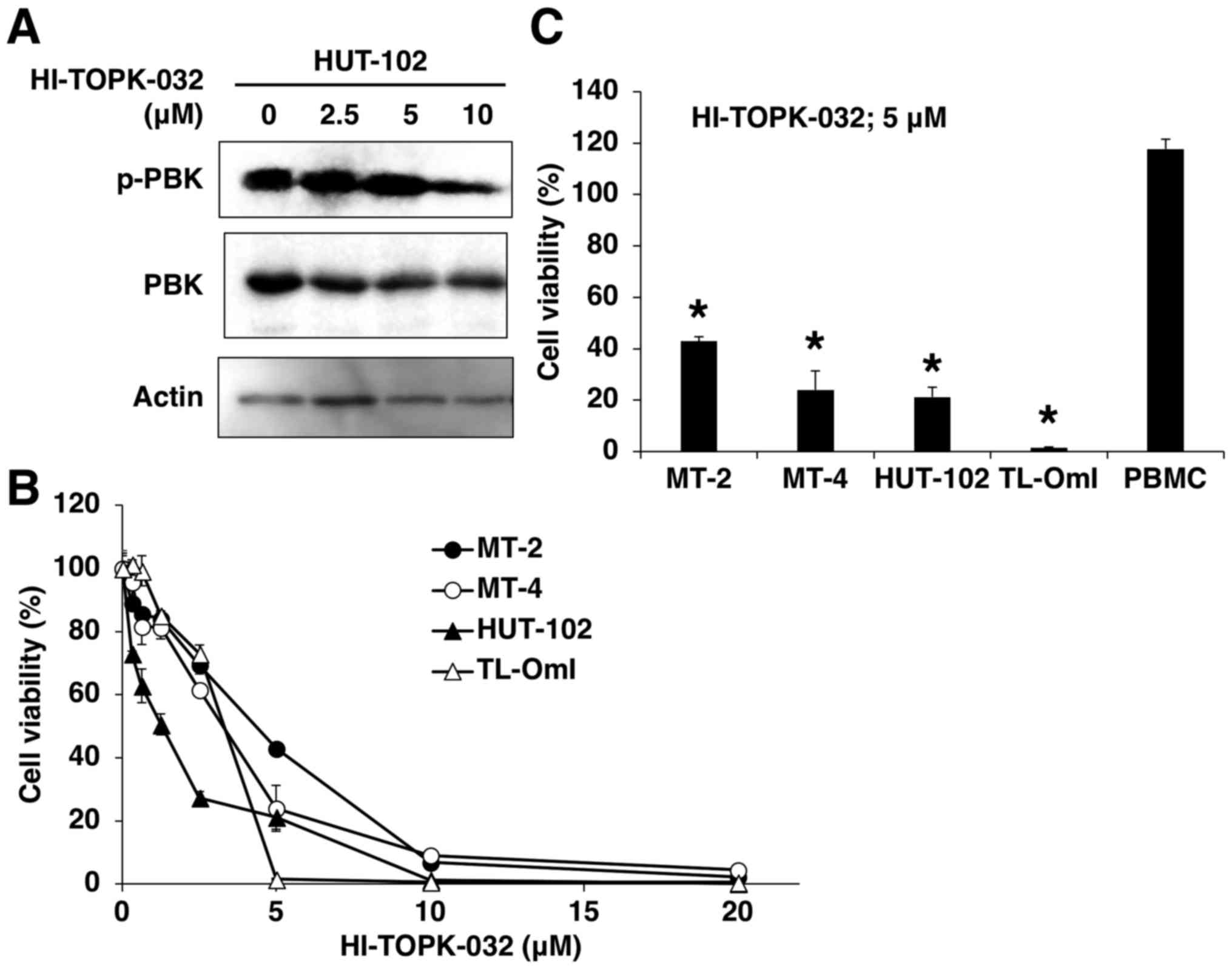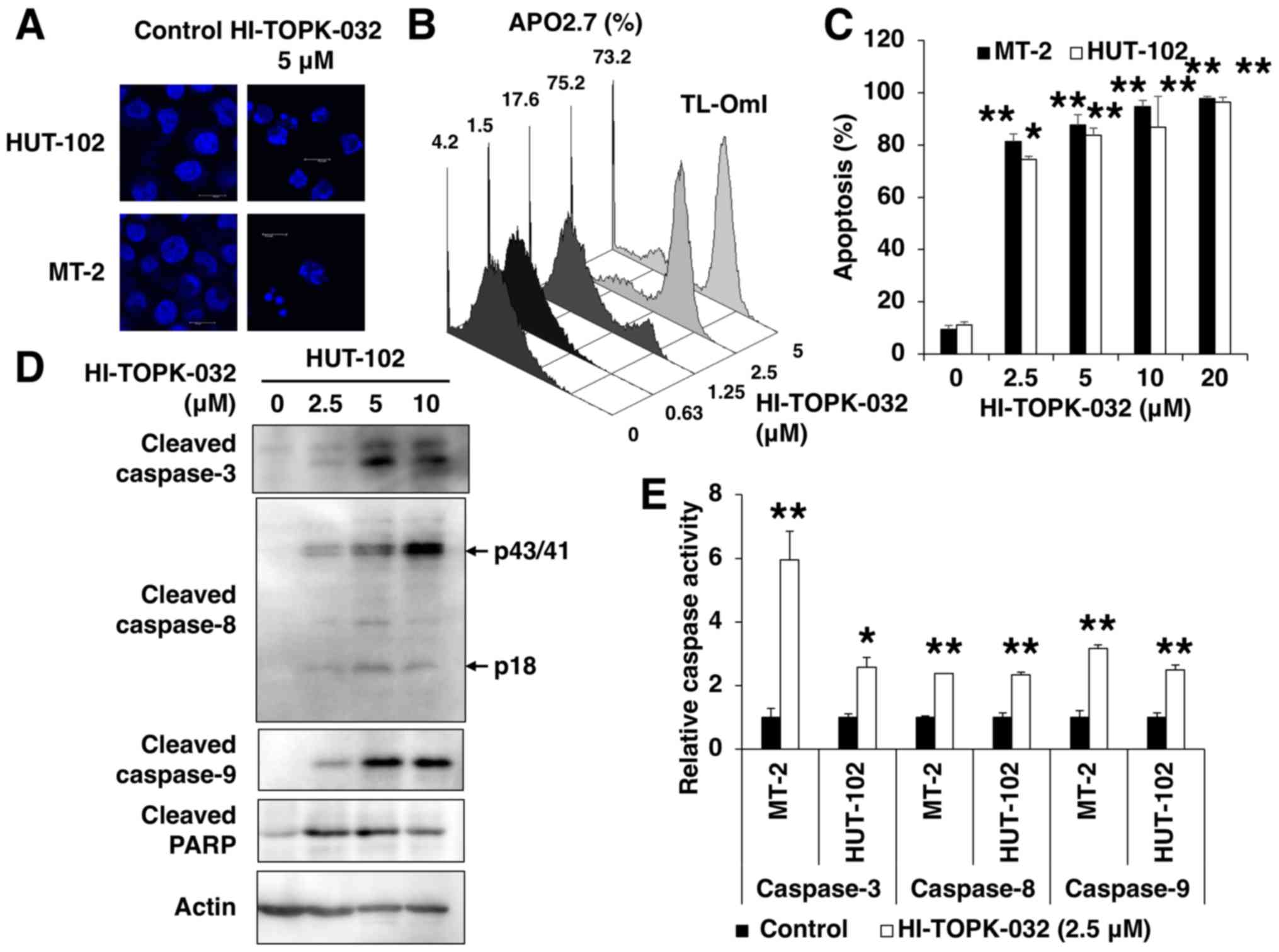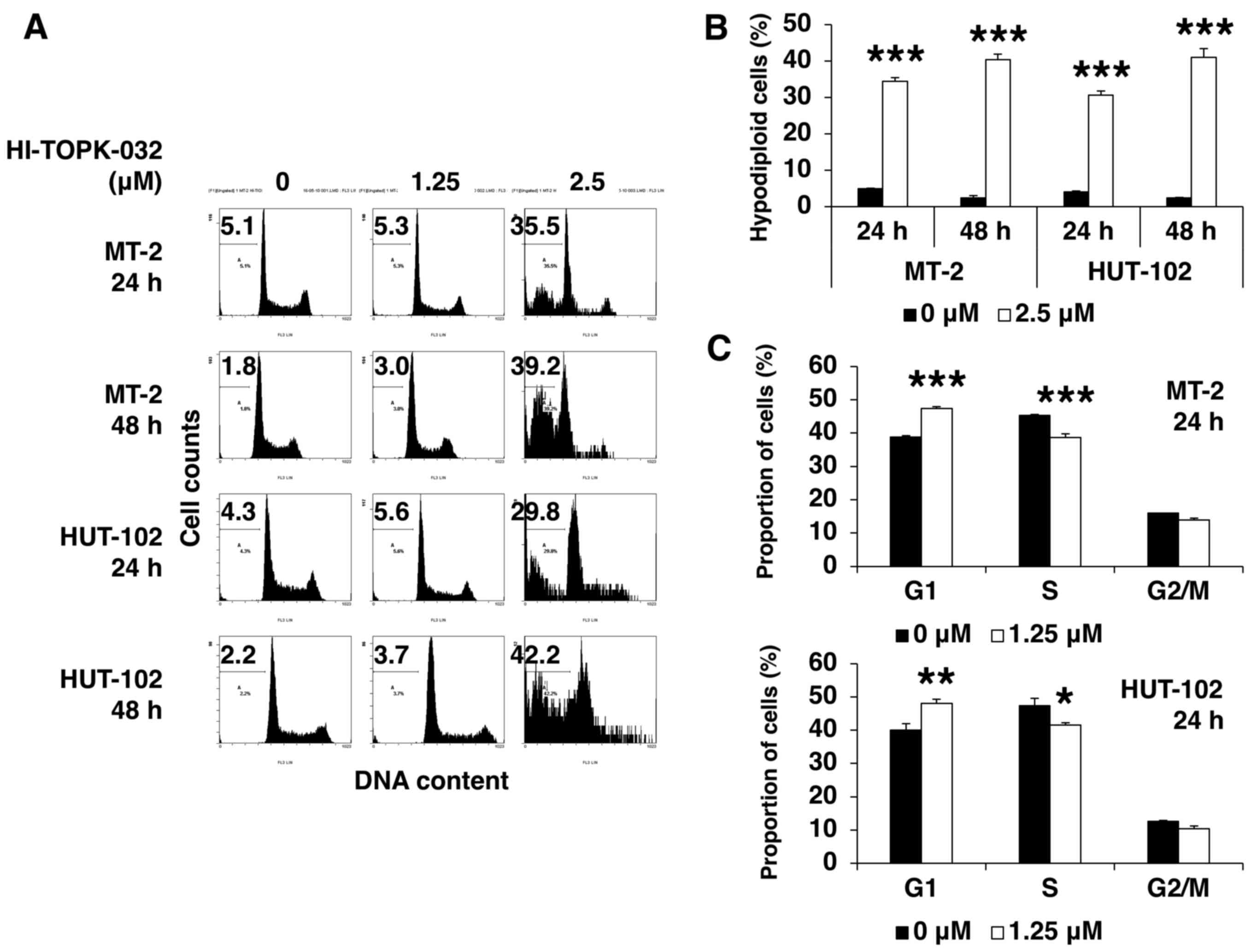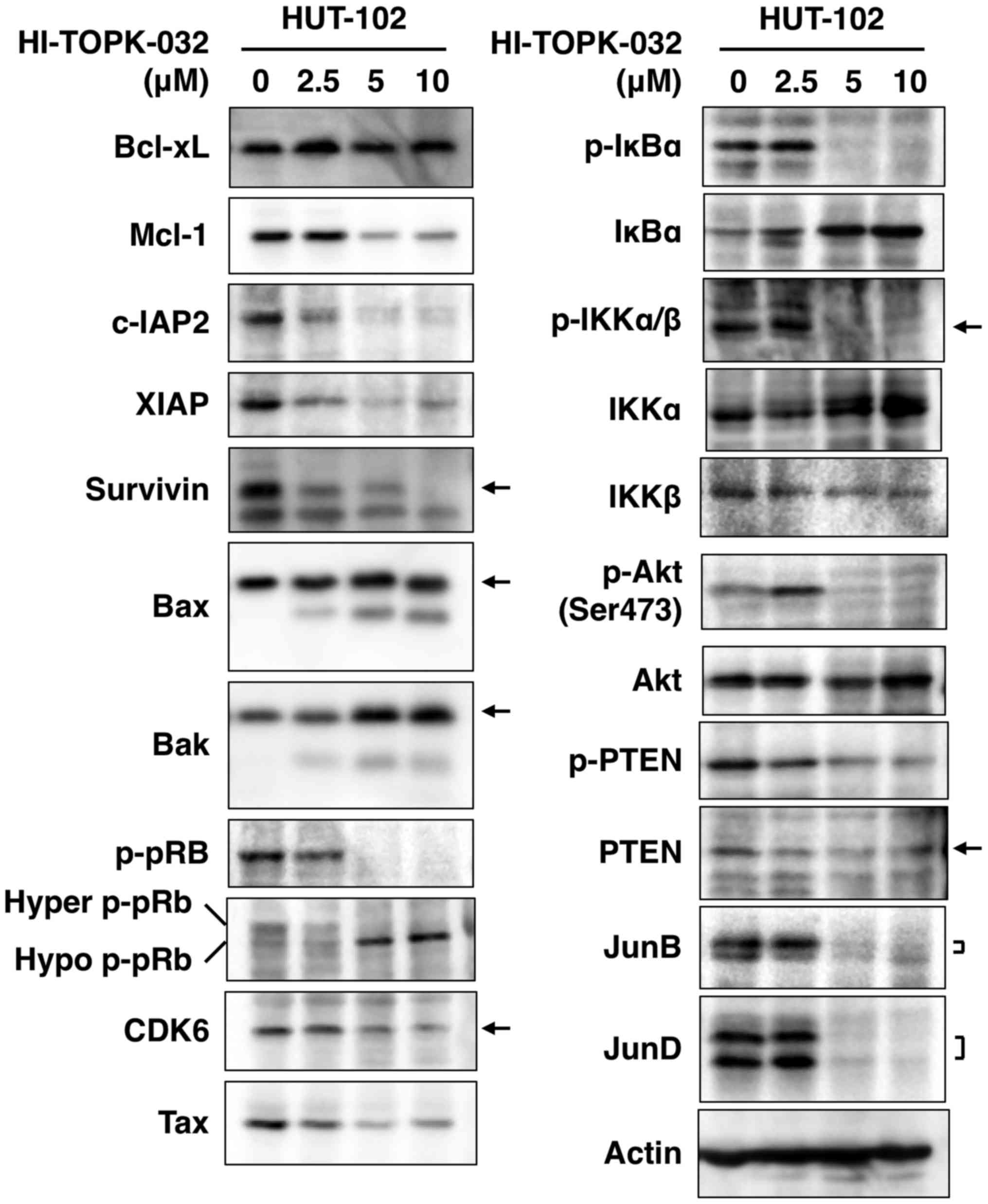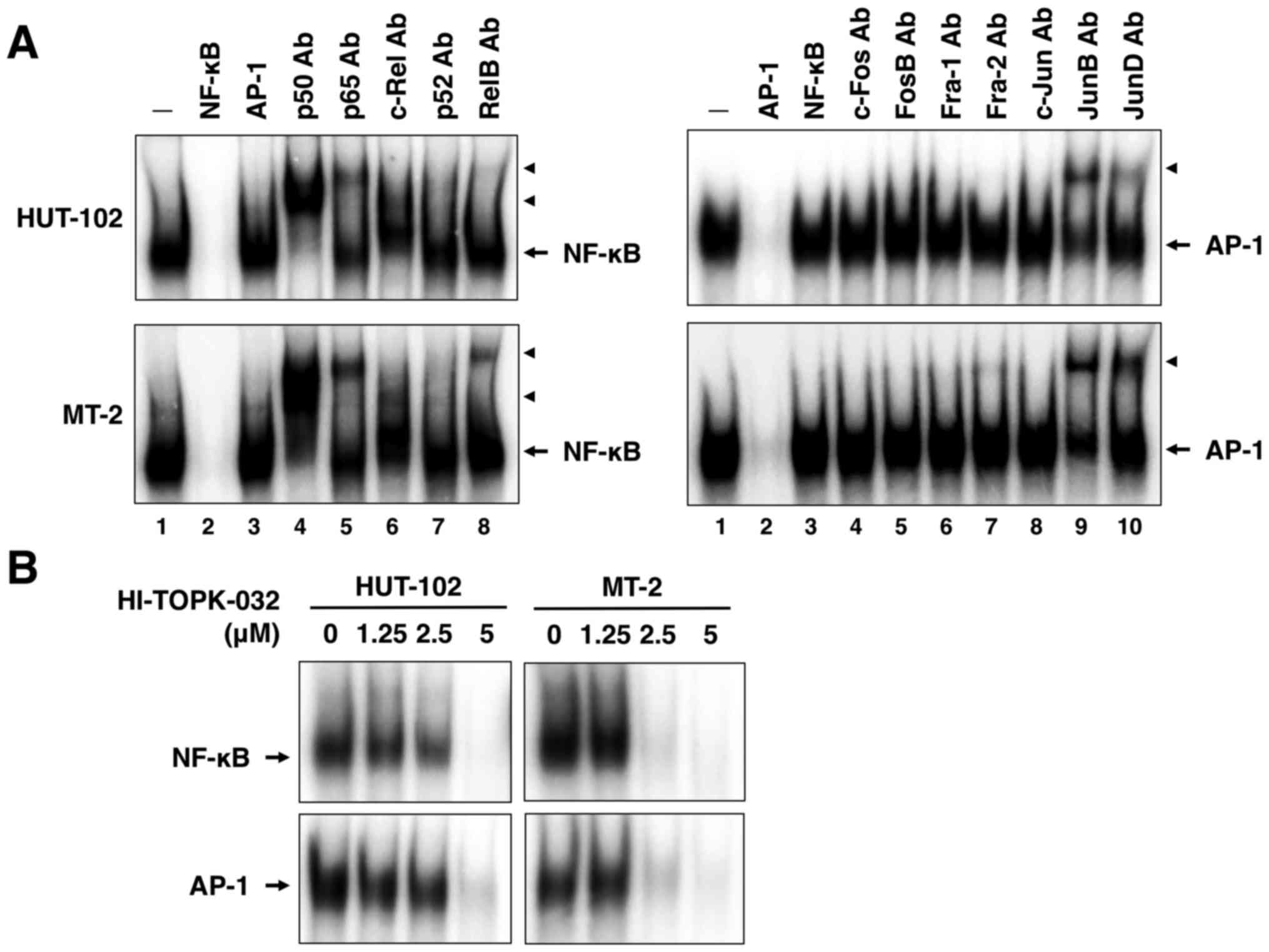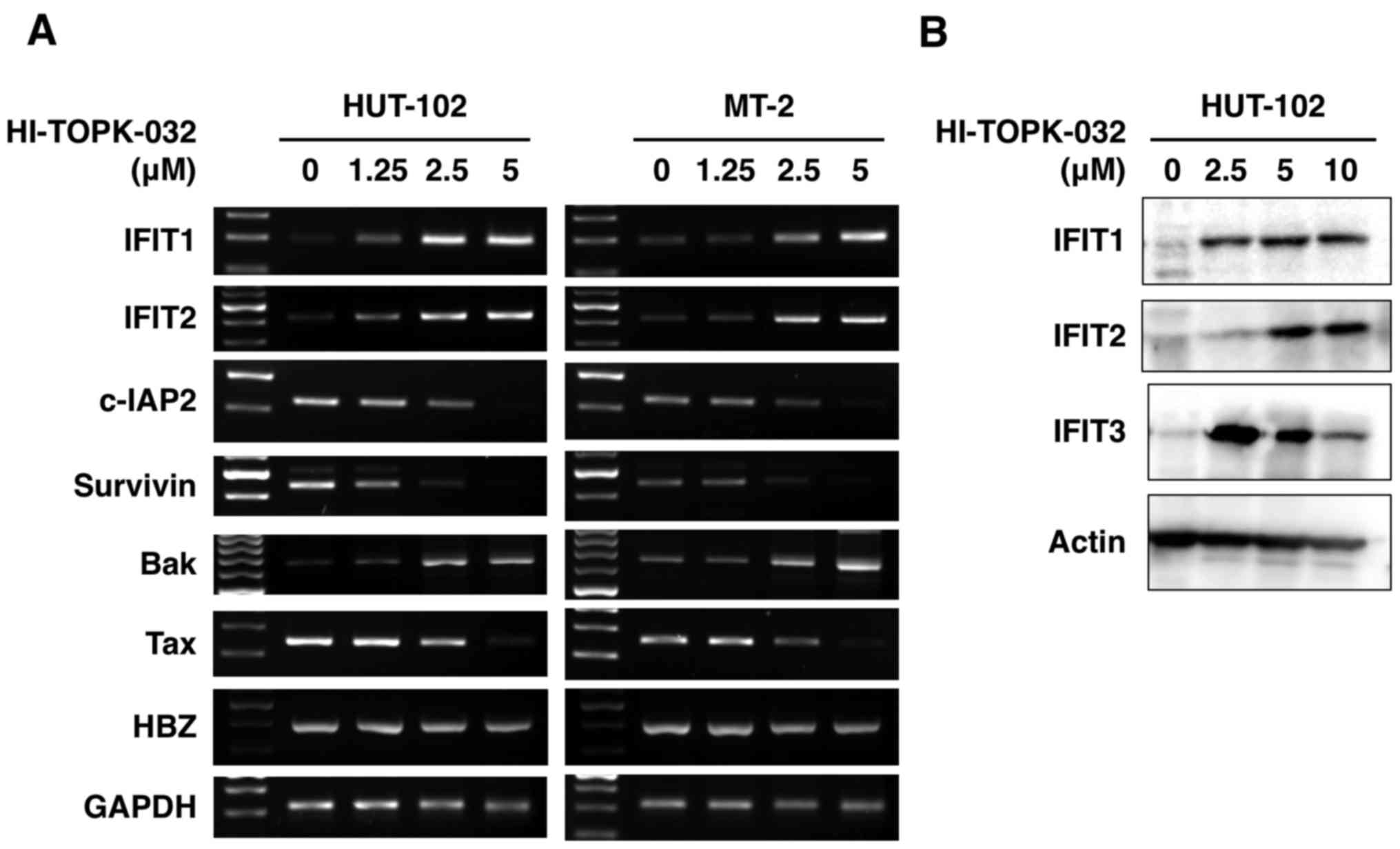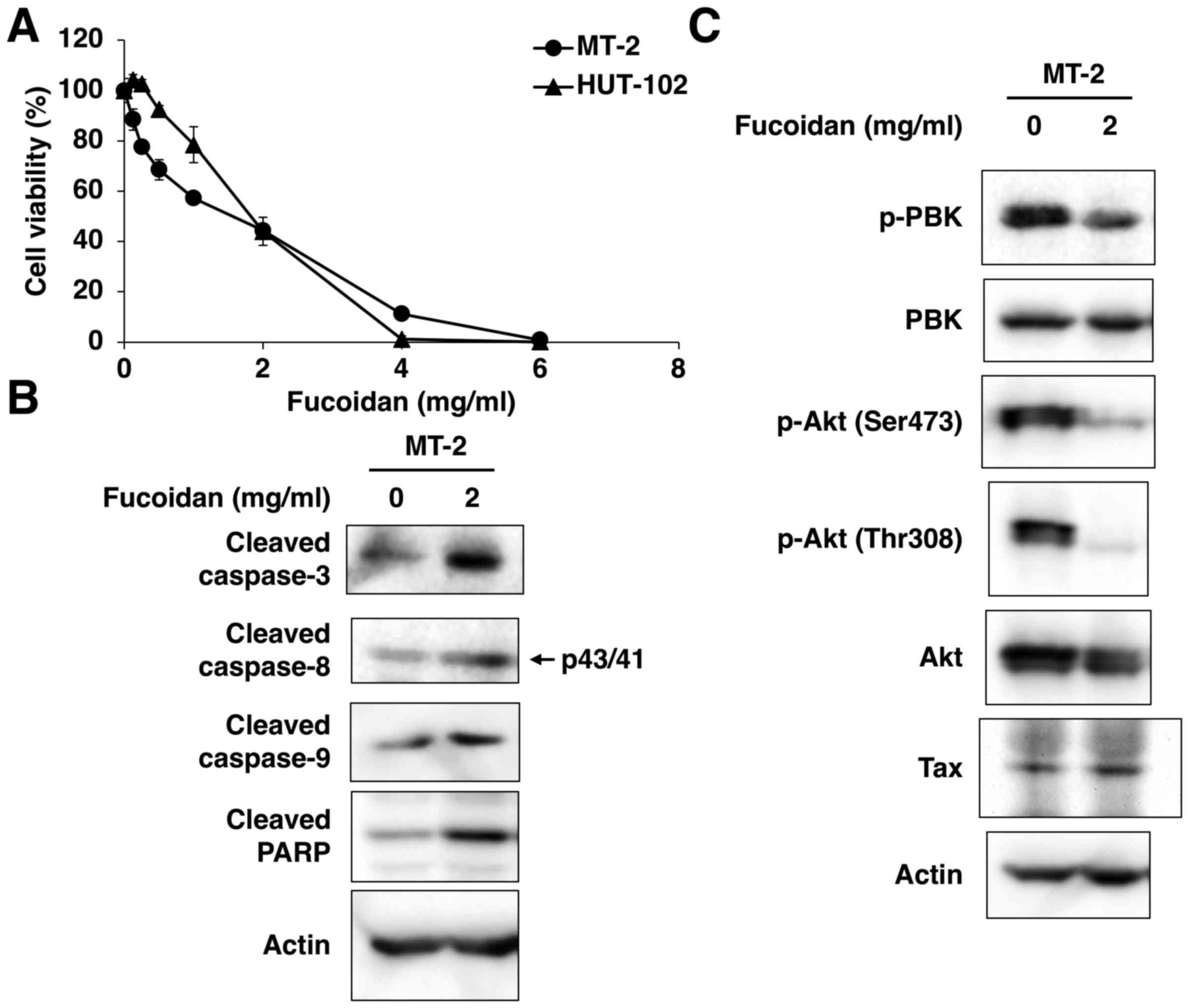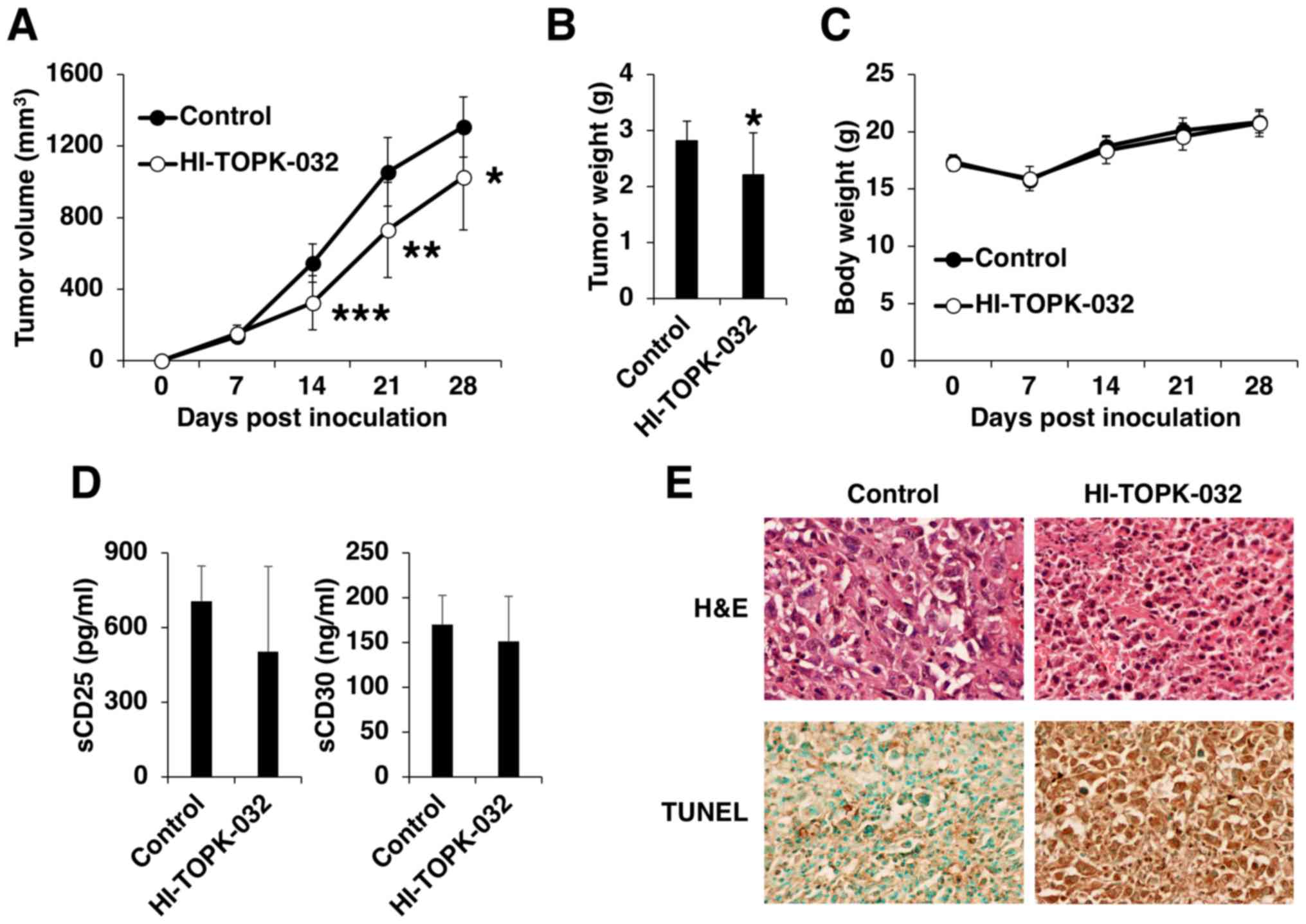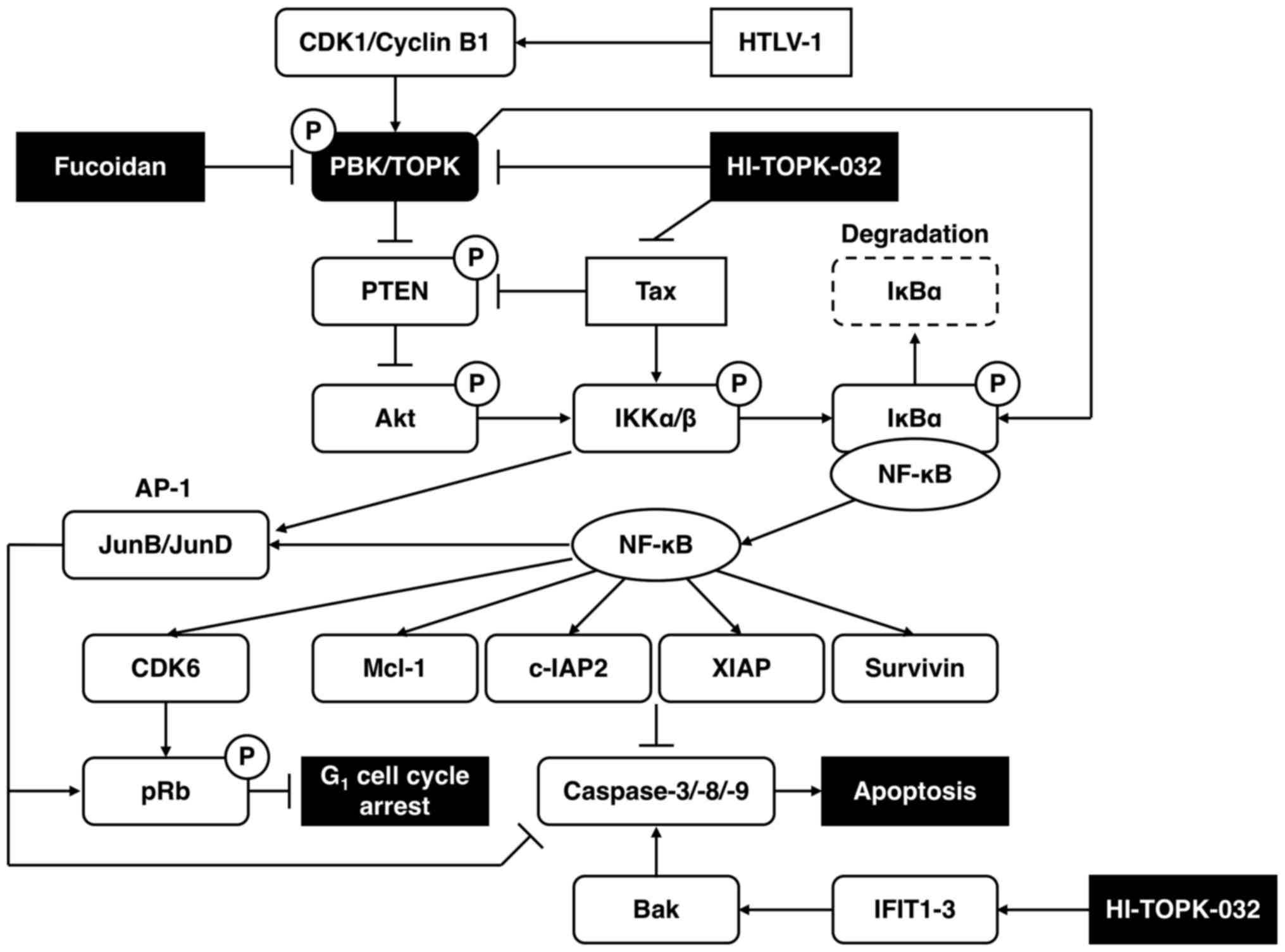Introduction
Adult T-cell leukemia/lymphoma (ATLL) is an
aggressive neoplasm of CD4+ T cells linked to human
T-cell leukemia virus type 1 (HTLV-1) infection (1). Although the molecular mechanisms
responsible for the genesis of ATLL are not yet fully understood,
there is a general agreement that HTLV-1 induces oncogenesis
through the deregulation of selected cellular signaling pathways,
such as nuclear factor-κB (NF-κB), activator protein-1 (AP-1) and
Akt, resulting in the transactivation of the expression of numerous
cellular genes, which leads to dysregulated growth and
transformation (2–4). In particular, the viral regulatory
protein Tax is thought to play important roles in the oncogenic
process of ATLL (5).
Despite advances in the development of novel
therapeutic agents, many ATLL patients are resistant to
chemotherapy and exhibit a poor prognosis (1). Therefore, novel and innovative
approaches are greatly needed in order to advance ATLL treatment
options. As ATLL cells are adapted to the dysregulation of kinases,
it is compelling to target them to lead to marked antitumor
responses.
PDZ-binding kinase (PBK) [also known as
T-lymphokine-activated killer cell-originated protein kinase
(TOPK)] is a serine/threonine kinase known to be highly expressed
in hematologic neoplasms, such as myeloid leukemia and B-cell
lymphoma (6–8). By contrast, its expression is limited
to the testis in normal organs and tissues (6). The expression of PBK/TOPK is
upregulated and phosphorylated during mitosis (6–8). It
binds to and is phosphorylated at Thr9 and is activated by the
CDK1/cyclin B1 complex (9,10). PBK/TOPK is included in the
'consensus stemness ranking signature' gene list, which is
upregulated in cancer stem cell-rich tumors, and associated with a
poor prognosis in various types of tumor (11). These studies suggest that PBK/TOPK
may exhibit an oncogenic cellular function and its inhibition may
be useful in cancer therapy.
In this study, we report the overexpression of
PBK/TOPK in HTLV-1-infected T-cell lines, and that treatment with
HI-TOPK-032 and fucoidan, PBK/TOPK inhibitors, results in the
inhibition of the growth and viability of these cell lines. We
demonstrate that HI-TOPK-032 induces G1 cell cycle
arrest and apoptosis by affecting the NF-κB, Akt, AP-1 and
interferon (IFN) signaling pathways. Furthermore, we demonstrated
the administration of HI-TOPK-032 results in the suppression of
tumor growth in a xenograft model. These results suggest that
PBK/TOPK may be a promising molecular target in ATLL treatment.
Materials and methods
Reagents and antibodies
HI-TOPK-032 (cat. no. 614849) was purchased from
Calbiochem (San Diego, CA, USA), dissolved in dimethyl sulfoxide
(cat. no. 13407-45, Nacalai Tesque, Inc., Kyoto, Japan). Fucoidan
was prepared from the brown algae Cladosiphon okamuranus
Tokida cultivated in Okinawa as previously described in detail
(12). Antibodies against PBK/TOPK
(cat. no. 4942), phospho-PBK/TOPK (Thr9) (cat. no. 4941), Bcl-xL
(cat. no. 2762), Bax (cat. no. 2772), Bak (cat. no. 3814), survivin
(cat. no. 2808), phosphatase and tensin homologue (PTEN) (cat. no.
9556), phospho-PTEN (Ser380) (cat. no. 9551), Akt (cat. no. 9272),
phospho-Akt (Thr308) (cat. no. 13038), phospho-Akt (Ser473) (cat.
no. 4060), phospho-IκBα (Ser32 and 36) (cat. no. 9246), IκB kinase
(IKK)α (cat. no. 2682), IKKβ (cat. no. 2684), phospho-IKKα/β
(Ser176/180 and Ser177/181) (cat. no. 2694), cleaved caspase-3
(cat. no. 9664), cleaved caspase-8 (cat. no. 9496), cleaved
caspase-9 (cat. no. 9501) and poly(ADP-ribose) polymerase (PARP)
(cat. no. 9541) were purchased from Cell Signaling Technology, Inc.
(Beverly, MA, USA). Antibodies against cyclin B1 (cat. no. MS-868),
CDK1 (cat. no. MS-275), CDK6 (cat. no. MS-398), retinoblastoma
protein (pRb) (cat. no. MS-107) and actin (cat. no. MS-1295) were
obtained from Neomarkers, Inc. (Fremont, CA, USA). Antibodies
against XIAP (cat. no. M044-3) and phospho-pRb (Ser780) (cat. no.
M054-3S) were purchased from Medical & Biological Laboratories,
Co. (Aichi, Japan). Antibodies against c-IAP2 (cat. no. sc-7944),
Mcl-1 (cat. no. sc-819), IκBα (cat. no. sc-371), JunB (cat. no.
sc-46), JunD (cat. no. sc-74), IFN-induced protein with
tetratricopeptide repeats (IFIT)1 (cat. no. sc-134948), IFIT2 (cat.
no. sc-390724), IFIT3 (cat. no. sc-393396) and NF-κB subunits p50
(cat. no. sc-114X), p52 (cat. no. sc-298X), RelA (cat. no.
sc-109X), c-Rel (cat. no. sc-70X) and RelB (cat. no. sc-226X) and
AP-1 subunits c-Fos (cat. no. sc-52X), FosB (cat. no. sc-48X),
Fra-1 (cat. no. sc-605X), Fra-2 (cat. no. sc-604X), c-Jun (cat. no.
sc-45X), JunB (cat. no. sc-46X) and JunD (cat. no. sc-74X) for
supershift assay were obtained from Santa Cruz Biotechnology, Inc.
(Santa Cruz, CA, USA). Lt-4, an antibody against Tax, was
previously described (13).
Cells and cell culture
The HTLV-1-transformed MT-2, MT-4, C5/MJ, SLB-1 and
HUT-102, and ATLL-derived MT-1, TL-OmI and ED-40515(−) T-cell
lines, were maintained in RPMI-1640 medium (cat. no. 30264-56;
Nacalai Tesque, Inc.) supplemented with 10% heat-inactivated fetal
bovine serum (Biological Industries, Kibbutz Beit Haemek, Israel)
and 1% penicillin/streptomycin (cat. no. 09367-34, Nacalai Tesque,
Inc.) at 37°C in a humidified incubator under 5% CO2.
The C5/MJ, HUT-102 and MT-1 cells were obtained from Fujisaki Cell
Center, Hayashibara Laboratories, Inc. (Okayama, Japan). The MT-2
and MT-4 cells were kindly provided by Dr Naoki Yamamoto (Tokyo
Medical and Dental University, Tokyo, Japan). The SLB-1 and
ED-40515(−) cells were provided by Dr Diane Prager (UCLA School of
Medicine, Los Angeles, CA, USA) and Dr Michiyuki Maeda (Kyoto
University, Kyoto, Japan), respectively. The TL-OmI cell line was
provided by Dr Masahiro Fujii (Niigata University, Niigata, Japan).
The study also included peripheral blood mononuclear cells (PBMCs)
obtained from healthy donors (cat. no. HC-0001; Lifeline Cell
Technology, Frederick, MD, USA). The PBMCs were stimulated with 20
µg/ml of phytohemagglutinin (PHA) (cat. no. L8754;
Sigma-Aldrich Co., St. Louis, MO, USA) for 72 h.
HTLV-1 infection by co-cultivation
The MT-2 cells that produce viral particles were
pre-treated with 200 µg/ml of mitomycin C (MMC) (cat. no.
M0503; Sigma-Aldrich Co.) for 1 h, pipetted vigorously, and washed
3 times with phosphate-buffered saline. PBMCs from healthy donors
(Lifeline Cell Technology) and MMC-treated MT-2 cells were
co-cultured in the presence of 10 ng/ml of interleukin (IL)-2
(kindly provided by Takeda Pharmaceutical Company Ltd., Osaka,
Japan). The culture medium was half-changed with fresh medium
supplemented with IL-2 every 3 days. As the MT-2 cells were
pre-treated extensively with MMC, no discernible MT-2 cells were
found.
Western blot analysis
Whole cell extracts were prepared by subjecting the
treated cells to lysis with lysis buffer [62.5 mM Tris-HCl (pH 6.8)
(cat. no. 35434-21), 2% sodium dodecyl sulfate (cat. no. 31607-65),
10% glycerol (cat. no. 17045-65), 6% 2-mercaptoethanol (cat. no.
21438-82; all from Nacalai Tesque, Inc.) and 0.01% bromophenol blue
(cat. no. 021-02911; Wako Pure Chemical Industries, Osaka, Japan)].
Protein concentrations were determined using a commercial kit (DC
Protein Assay, cat. no. 5000116JA; Bio-Rad Laboratories, Inc.,
Hercules, CA, USA). Lysate protein (20 µg) was subjected to
8–15% sodium dodecyl sulfate-polyacrylamide gels (SDS-PAGE),
electrotransferred onto polyvinylidene difluoride membranes (cat.
no. IPVH00010EMD; Millipore, Darmstadt, Germany). The membranes
were blocked with 4% non-fat dry milk (cat no. 9999; Cell Signaling
Technology, Inc.) for 1 h at room temperature, and blotted
overnight with the respective antibody (1:1,000). Finally, the
blots were hybridized with horseradish peroxidase-conjugated
secondary anti-mouse (1:1,000) (cat. no. 7076; Cell Signaling
Technology, Inc.) or anti-rabbit IgG antibody (1:1,000) (cat. no.
7074; Cell Signaling Technology, Inc.), and visualized using an
enhanced chemiluminescence reagent (cat. no. RPN2232; Amersham
Biosciences Corp., Piscataway, NJ, USA).
DNA microarray analysis
The HUT-102 and MT-2 cells were treated with 5
µM of HI-TOPK-032. After 24 h, total RNA was extracted using
the RNeasy Plus Mini kit (Qiagen, Hilden, Germany). Microarray
analysis using a SurePrint G3 Human GE 8×60 K Microarray kit
version 3.0 (Agilent Technologies, Inc., Waldbronn, Germany) was
performed as previously described (14).
RT-PCR
TRIzol reagent (cat. no. 15596026; Invitrogen Life
Technologies, Carlsbad, CA, USA) was used to extract total RNA from
the cells. A total of 1 µg RNA was reverse transcribed into
cDNA using a PrimeScript RT-PCR kit (cat. no. RR014A; Takara Bio,
Inc., Otsu, Japan). The sequence-specific primers used for RT-PCR
are summarized in Table I. The PCR
cycling conditions were as follows: 94°C for 2 min, followed by
25–35 cycles of 94°C for 1 min, 54–60°C for 1 min and 72°C for 1
min, with a final extension step of 72°C for 5 min.
 | Table IPrimer sequences used in RT-PCR. |
Table I
Primer sequences used in RT-PCR.
| Name | Forward (5′) | Reverse (3′) |
|---|
| PBK/TOPK |
AGACCCTAAAGATCGTCCTTCTG |
GTGTTTTAAGTCAGCATGAGCAG |
| Tax |
CCGGCGCTGCTCTCATCCCGGT |
GGCCGAACATAGTCCCCCAGAG |
| HBZ |
GAATTGGTGGACGGGCTATTATC |
TAGCACTATGCTGTTTCGCCTTC |
| IL-2Rα |
ATCCCACACGCCACATTCAAAGC |
TGCCCCACCACGAAATGATAAAT |
| IFIT1 |
GACAGGAAGCTGAAGGAGAAAA |
TAGCAAAGCCCTATCTGGTGAT |
| IFIT2 |
ACAAGGCCATCCACCACTTTAT |
CCCAGCAATTCAGGTGTTAACA |
| c-IAP2 |
CCATATGCTCACTCAGATGATGT |
GTGTATCATCTCCACAGAGAGTT |
| Survivin |
GGCATGGGTGCCCCGACGTTG |
CAGAGGCCTCAATCCATGGCA |
| Bak |
TGAAAAATGGCTTCGGGGCAAGGC |
TCATGATTTGAAGAATCTTCGTACC |
| GAPDH |
GCCAAGGTCATCCATGACAACTTTGG |
GCCTGCTTCACCACCTTCTTGATGTC |
Cell proliferation and cytotoxic
assay
The water-soluble tetrazolium (WST)-8 uptake method
was used to assess the cell proliferative and toxic effects of
HI-TOPK-032 (0.31–20 µM) and fucoidan (0.13–6 mg/ml) for 48
h. The cells were plated in 96-well flat microtiter plates in
triplicate and treated as indicated for 48 h prior to the WST-8
assay. A total of 10 µl of the WST-8 reagent (cat. no.
07553-44; Nacalai Tesque, Inc.) were added to each well. After a
4-h reaction, WST-8 reduction was measured at 450 nm using a Wallac
1420 Multilabel Counter (PerkinElmer, Inc., Waltham, MA, USA). The
values were normalized to the untreated control samples.
Analysis of cell apoptosis
The cells were treated with HI-TOPK-032 (0.63–20
µM) for 24 h and then permeabilized by incubation on ice for
20 min with 100 µg/ml of digitonin, and treated with the
phycoerythrin-conjugated APO2.7 antibody (cat. no. IM2088; Beckman
Coulter, Inc., Marseille, France) for 15 min at room temperature.
After staining with APO2.7 antibody, the induction of apoptosis was
determined by Epics XL flow cytometry (Beckman Coulter, Inc., Brea,
CA, USA). In addition, for the analysis of morphological changes in
the nuclei, the cells were stained by 10 µg/ml of Hoechst
33342 (cat. no. 346-07951; Dojindo Molecular Technologies, Inc.,
Kumamoto, Japan) and observed under a Leica DMI6000 microscope
(Leica Microsystems, Wetzlar, Germany).
Measurement of caspase activity
Caspase activity was assessed using Colorimetric
Caspase Assay kits (cat. nos. 4800, 4805 and 4810; Medical &
Biological Laboratories, Co.). Briefly, the cell extracts were
recovered using the cell lysis buffer supplied with the kit, and
assessed for caspase−3, −8 and −9 activities using respective
colorimetric probe. The kits are based on the detection of
chromophore ϱ-nitroanilide after cleavage from caspase-specific
labeled substrates. Colorimetric readings were determined with a
microplate reader (Wallac 1420 Multilabel Counter; PerkinElmer,
Inc.).
Cell cycle analysis
The cells were stained with the CycleTEST Plus DNA
Reagent kit (cat. no. 340242; Becton-Dickinson Immunocytometry
Systems, San Jose, CA, USA). The cell cycle distribution was
analyzed by an Epics XL flow cytometry that uses the MultiCycle
software (version 3.0; Phoenix Flow Systems, San Diego, CA, USA).
The population of nuclei at each phase of the cell cycle was
determined, and apoptotic cells with hypodiploid DNA content were
detected in the sub-G1 region.
Electrophoretic mobility shift assay
(EMSA)
To determine NF-κB and AP-1 activation, we prepared
nuclear extracts from the HI-TOPK-032-treated cells and performed
EMSA, as previously described in detail (15). Nuclear extracts were incubated with
32P-labeled probes. The top strand sequences of the
oligonucleotide probes or competitors were as follows: For a
typical NF-κB element of the IL-2 receptor α chain (IL-2Rα)
gene, 5′-GATCCGGCAGGGGAATCTCCCTCTC-3′ and for the
consensus AP-1 element of the IL- 8 gene,
5′-GATCGTGATGACTCAGGTT-3′. The above
underlined sequences are the NF-κB and AP-1 binding sites,
respectively. In the competition experiments, nuclear extracts were
pre-incubated for 15 min with 100-fold excess of unlabeled
oligonucleotides. For supershift assays, nuclear extracts were
incubated with antibodies against NF-κB or AP-1 subunits for 45 min
at room temperature before the complex was analyzed by EMSA. The
dried gels were visualized using a Pharos FX Plus System (Bio-Rad
Laboratories Inc.).
Xenograft tumor model
Eighteen 5-week-old female C.B-17/Icr-severe
combined immunodeficient (SCID) mice were obtained from Kyudo, Co.
(Tosu, Japan). The HUT-102 cells (1×107/0.2 ml RPMI-1640
medium) were inoculated subcutaneously into the post-auricular
region of the SCID mice. The mice were divided into 2 groups (n=9,
each). HI-TOPK-032 was solubilized in 5.2% polyethylene glycol 400
(cat. no. 161-09065; Wako Pure Chemical Industries) and 5.2%
Tween-80 (cat. no. 231181; Becton-Dickinson, Franklin Lakes, NJ,
USA), and administrated at a dose of 12.5 mg/kg intraperitoneally 5
times a week. The treatment was continued for 4 weeks, beginning on
the day after cell inoculation. The control group received the
vehicle (5.2% polyethylene glycol 400 and 5.2% Tween-80) only. The
tumor diameter was measured weekly with a shifting caliper and
tumor volume was calculated. The body weights were also measured
weekly. All mice were sacrificed on day 28. The tumors were excised
and their weights measured. Blood samples were collected from mice
under deep terminal anesthesia by cardiac puncture, and the sera
were stored at −80°C until assayed for soluble IL-2Rα [soluble
cluster of differentiation 25 (sCD25)] and sCD30. This experiment
was performed according to the Guidelines for Animal
Experimentation of the University of the Ryukyus (Nishihara,
Japan), and was approved by the Animal Care and Use Committee of
the University (reference no. A2016073).
Morphological analysis of tumor tissues
and terminal deoxy- nucleotidyl transferase deoxyuridine
triphosphate nick end labeling (TUNEL) assay
The tumor specimens were collected from the treated
or untreated mice, fixed in formalin solution (Wako Pure Chemical
Industries), dehydrated through graded ethanol series (Japan
Alcohol Selling Co., Tokyo, Japan), and embedded in paraffin (cat.
no. 09620; Sakura Finetek Japan Co., Tokyo, Japan). The
paraffin-embedded specimens of ATLL tumors were stained with
hematoxylin and eosin (H&E, cat. nos. 234-12 and 1159350025;
Merck, Darmstadt, Germany), and examined histologically. The
analysis of DNA fragmentation by TUNEL assay was performed using a
commercial kit (cat. no. 11684817910; Roche Applied Science,
Penzberg, Germany) according to the instructions supplied by the
manufacturer. The cells were examined under a light microscope
(Axioskop 2 Plus) with an Achroplan 40x/0.65 lens (both from Zeiss,
Hallbergmoos, Germany). Images were acquired with an AxioCam 503
color and AxioVision LE64 software (Zeiss).
Biomarker analysis
Serum concentrations of human sCD25 (cat. no.
950.500.048; Diaclone SAS, Besançon, France) and human sCD30 (cat.
no. BMS240; Affymetrix eBioscience, San Diego, CA, USA) were
assessed in the treated and untreated mice by enzyme-linked
immunosorbent assay (ELISA), according to the protocol supplied by
the manufacturer.
Statistical analysis
The results are expressed as the means ± standard
deviation (SD). The Student's t-test or ANOVA with Tukey-Kramer
statistical tests were used to evaluate the data of 2 groups or
more than 2 groups, respectively. Differences were considered
statistically significant at P<0.05.
Results
Upregulation and phosphorylation of
PBK/TOPK in HTLV-1- infected T-cell lines
To assess PBK/TOPK expression in HTLV-1-infected
T-cell lines, we examined the protein levels of PBK/TOPK. The
protein levels were determined in 5 HTLV-1-transformed T-cell lines
(Fig. 1A, lanes 1–5) and in 3
ATLL-derived T-cell lines (Fig.
1A, lanes 6–8) and compared with those in PBMCs from two
healthy donors (Fig. 1A, lanes 9
and 10), using western blot analysis. HTLV-1-transformed T-cell
lines constitutively expressed Tax at protein and mRNA levels
(Fig. 1A and B). Western blot
analysis revealed that PBK/TOPK protein expression was markedly
higher in the HTLV-1-infected T-cell lines than in the PBMCs from
healthy donors (Fig. 1A). RT-PCR
analysis confirmed the elevated mRNA expression of PBK/TOPK in the
HTLV-1-infected T-cell lines compared to PBMCs from healthy donors
(Fig. 1B). The phosphorylation of
PBK/TOPK by CDK1/cyclin B1 is required for its mitotic activity
(9,10). We found that PBK/TOPK was
constitutively phosphorylated and CDK1/cyclin B1 was strongly
expressed in all HTLV-1-infected T-cell lines. By contrast, no
phosphorylation of PBK/TOPK and no expression of CDK1/cyclin B1
were detected by western blot analysis in the PBMCs of healthy
donors (Fig. 1A, lanes 9 and 10).
Notably, PHA stimulation induced the expression of PBK/TOPK at the
protein and mRNA levels, the phosphorylation of PBK/TOPK, and the
protein expression of CDK1/cyclin B1 in PBMCs (Fig. 1A and B).
PBK/TOPK expression in HTLV-1-infected
cells
To examine whether HTLV-1 infection can induce
PBK/TOPK expression, we co-cultured PBMCs and MMC-treated MT-2
cells. At 7 days after co-cultivation, the PBMCs were harvested for
the assessment of viral gene expression by RT-PCR. The PBMCs
co-cultured with MMC-treated MT-2 cells expressed Tax mRNA
(Fig. 1C). Furthermore, the
expression levels of PBK/TOPK and IL-2Rα, one of the known target
genes of Tax (16), increased in
these cells following induction of Tax expression. These results
suggest that HTLV-1 infection induces the expression of PBK/TOPK in
PBMCs.
HI-TOPK-032 inhibits cell viability
The PBK/TOPK inhibitor, HI-TOPK-032, is known to
bind the active site of PBK/TOPK (17). In this study, HI-TOPK-032
suppressed the phosphorylation of PBK/TOPK (Fig. 2A). To examine the effects of
HI-TOPK-032, HTLV-1-infected T-cell lines were treated with various
concentrations of HI-TOPK-032 for 48 h, and cell viability was
assessed by WST-8 assay. Cell viability was inhibited in a
dose-dependent manner (Fig. 2B).
The effect of HI-TOPK-032 on the viability of PBMCs was less
pronounced at the 5 µM concentration (Fig. 2C).
HI-TOPK-032 induces apoptosis with the
cleavage and activation of caspases
First, the morphological changes induced by
HI-TOPK-032 were examined using microscopy. The cells treated with
HI-TOPK-032 for 48 h demonstrated morphological characteristics of
apoptosis, such as chromatin condensation and nuclear fragmentation
(Fig. 3A). Next, the induction of
apoptosis by HI-TOPK-032 was measured using three commonly used
assays: APO2.7 staining (Fig. 3B and
C), the cleavage of caspases (Fig.
3D) and the activation of caspases (Fig. 3E). The mitochondrial membrane
antigen, APO2.7, is known to be expressed during apoptosis
(18). Treatment with HI-TOPK-032
resulted in an increase in the proportion of APO2.7-positive
apoptotic cells in a dose-dependent manner (Fig. 3B and C). Western blots of the cells
treated with HI-TOPK-032 revealed that apoptosis was accompanied by
an increase in the cleavage of caspase−3, −8, −9 and PARP, a
substrate for caspase-3 (Fig. 3D).
The activation of caspase−3, −8 and −9 was also detected in the
cells treated with 2.5 µM of HI-TOPK-032 (Fig. 3E).
HI-TOPK-032 induces apoptosis and
G1 cell cycle arrest
To examine the effects of HI-TOPK-032 on cell cycle
progression, cell cycle analysis was performed on the cells. The
cells were treated with 1.25 or 2.5 µM of HI-TOPK-032 for
24–48 h. The percentages of cells in the sub-G1 phase of
the high-dose HI-TOPK-032 (2.5 µM) treatment group were
higher than those of the control group (Fig. 4A and B). In comparison, the
low-dose HI-TOPK-032 (1.25 µM) treatment group exhibited a
reduced proportion of cells in the S phase, but an increased
proportion of cells in the G1 phase population (Fig. 4A and C). These results indicate
that high-dose and low-dose HI-TOPK-032 induces the apoptosis of
and G1 cell cycle arrest in HTLV-1-infected T-cell
lines.
HI-TOPK-032 alters the expression of
apoptosis- and cell cycle-related proteins
We assessed the effects of HI-TOPK-032 on the
molecular cascades of apoptosis in HUT-102 cells. As shown in
Fig. 5, HI-TOPK-032 decreased the
expression of the anti-apoptotic proteins, Mcl-1, c-IAP2, XIAP and
survivin in the HUT-102 cells. By contrast, HI-TOPK-032 enhanced
the expression of pro-apoptotic protein, Bak. It had no significant
effects on the Bcl-xL and Bax protein levels. To examine the
mechanisms through which HI-TOPK-032 induces G1 cell
cycle arrest in the HUT-102 cells, the phosphorylation state of pRb
was evaluated by western blot analysis. HI-TOPK-032 decreased the
levels of the phosphorylated forms of pRb, and altered the
hyperphosphorylated form to a hypophosphorylated form of pRb
(Fig. 5). Next, we examined the
expression of CDK6 to clarify pRb phosphorylation. Treatment with
HI-TOPK-032 decreased the expression of CDK6 (Fig. 5).
Effects of HI-TOPK-032 on the
transcription factors, NF-κB and AP-1
Transcription factors are proteins that bind at a
specific promoter region of the DNA and regulate the expression of
various genes. NF-κB and AP-1 are closely linked with cell
survival, proliferation and transformation. Therefore, they are
important targets for therapeutic intervention in ATLL (3). Notably, Mcl-1, c-IAP2, XIAP, survivin
and CDK6 are NF-κB-regulated gene products (19–23).
As shown in Fig. 6A, the
DNA-binding of NF-κB and AP-1 was observed in the HUT-102 and MT-2
cells. These binding reactions were specific since cold
competitors, but not unrelated oligonucleotides, competed with each
DNA-binding activity (Fig. 6A,
lanes 2 and 3). The components of NF-κB and AP-1 DNA-binding
complexes were analyzed with specific antibodies against 5 NF-κB
family proteins and 7 AP-1 family proteins. The activated complexes
of NF-κB and AP-1 consisted of p50/p65/c-Rel/RelB (Fig. 6A, lanes 4–6 and 8) and JunB/JunD
(Fig. 6A, lanes 9 and 10),
respectively. We investigated whether HI-TOPK-032 inhibits the
constitutive NF-κB and AP-1 activation in HTLV-1-infected T-cell
lines. HI-TOPK-032 reduced the DNA-binding of NF-κB and AP-1 in a
dose-dependent manner (Fig. 6B).
Next, we examined the effect of HI-TOPK-032 on JunB/JunD
expression, as JunB/JunD are functional components of AP-1 in
HTLV-1-infected T-cell lines. Western blot analysis revealed that
HI-TOPK-032 inhibited the AP-1 signaling pathway through the
suppression of JunB/JunD protein levels (Fig. 5, right panel).
Effects of HI-TOPK-032 on NF-κB and Akt
signaling pathways
In the unstimulated state, NF-κB is sequestered in
the cytoplasm by binding to IκBα. In response to a variety of
stimuli including viruses, the IKK complex comprised of
IKKα/IKKβ/IKKγ is activated, and phosphorylates IκBα, which is
sequentially ubiquitinated and subjected to proteasomal degradation
(24). As PBK/TOPK was identified
as a novel upstream kinase of IκBα regulating NF-κB (25), we examined whether HI-TOPK-032
affects IκBα phosphorylation. HI-TOPK-032 inhibited the
phosphorylation and degradation of IκBα (Fig. 5). In addition, the inhibition of
PBK/TOPK by HI-TOPK-032 led to a slight decrement in the total IKKβ
levels and a significant reduction in phosphorylated IKKα/β levels.
The phosphoinositide 3-kinase (PI3K)-Akt signal is a component of a
pathway important for cell survival and growth during
carcinogenesis, and Akt utilizes IKKs for the activation of NF-κB
(26). The tumor suppressor, PTEN,
dephosphorylates phosphatidylinositol 3,4,5-triphosphate (PIP3) to
PI(4,5)P2, and opposes the PI3K-Akt signaling
(27). The loss of the
expression/activity of PTEN is among the most frequently occurring
in cancer (27). ATLL cells do not
harbor genetic changes in PTEN, but express high levels of
PTEN that is highly phosphorylated (28). Its phosphorylation maintains PTEN
in an inactive form (29). It has
been suggested that PBK/TOPK promotes Akt activation by inducing
PTEN phosphorylation (30). Thus,
we hypothesized that PBK/TOPK may regulate the PTEN-Akt pathway in
ATLL. The decreased PTEN phosphorylation levels upon HI-TOPK-032
treatment were associated with a decreased Akt phosphorylation
(Fig. 5), suggesting that the
PBK/TOPK-mediated phosphorylation of PTEN may lead to PTEN
inactivation and Akt activation in ATLL. Tax activates NF-κB by
interacting with IKKγ (5). In
addition, Tax activates Akt by inhibition of PTEN (31). We then examined the effect of
HI-TOPK-032 on Tax expression. As shown in Fig. 5, the amount of Tax in HUT-102 cells
decreased progressively with the increasing concentrations of
HI-TOPK-032. Therefore, Tax may also be a target of
HI-TOPK-032.
HI-TOPK-032 induces IFIT1-3
expression
To address the vital mechanisms of
HI-TOPK-032-induced cell death, we also used DNA microarray
analysis and compared the gene expression profiles of treated and
untreated cells. We selected the evaluation of only genes that were
upregulated by >20-fold (see the list of these genes in Table II). One notable conclusion that
can be drawn from Table II is
that genes associated with IFN regulation (IFIT1-3, OASL and
IFI44) are the most highly upregulated by HI-TOPK-032 in two
cell lines. IFIT1 plays a key role in suppression of growth and
promotion of apoptosis of cancer cells (32). IFIT2 promotes apoptosis through a
mitochondrial pathway dependent on the action of Bcl-2 proteins
(33). Bax and Bak are required
for apoptosis in response to IFIT2 (33). IFIT3 is also an anti-proliferative
IFN-induced protein (34). It was
important to confirm the microarray results with RT-PCR. Similar to
the results of the microarray analysis, the IFIT1 and
2 genes were overexpressed in the HUT-102 and MT-2 cells
(Fig. 7A). The IFIT1-3 protein
levels were also increased in the HUT-102 cells treated with
HI-TOPK-032 (Fig. 7B). These
results suggest the involvement of IFITs in HI-TOPK-032-induced
apoptosis. In addition, similar to the results of western blot
analysis, the downregulation of c-IAP2, survivin and Tax, and the
upregulation of Bak were confirmed by RT-PCR (Fig. 7A). The HTLV-1 basic leucine zipper
factor (HBZ), which is encoded by the minus-strand of the provirus,
is linked to oncogenic transformation in addition to Tax (35). Thus, we examined the level of HBZ
expression. However, HI-TOPK-032 did not affect the expression of
HBZ (Fig. 7A).
 | Table IIGenes with changes in expression
exceeding 20-fold found by microarray in HUT-102 and MT-2 cells
evaluated following exposure to 5 µM of HI-TOPK-032 for 24
h. |
Table II
Genes with changes in expression
exceeding 20-fold found by microarray in HUT-102 and MT-2 cells
evaluated following exposure to 5 µM of HI-TOPK-032 for 24
h.
| Symbol | Upregulated
genes | HUT-102 cells | MT-2 cells |
|---|
| IFIT2 | Interferon-induced
protein with tetratricopeptide repeats 2 | 94 | 236 |
| IFIT3 | Interferon-induced
protein with tetratricopeptide repeats 3 | 59 | 63 |
| IFIT1 | Interferon-induced
protein with tetratricopeptide repeats 1 | 51 | 49 |
| RNF150 | Ring finger protein
150 | 47 | 26 |
| BCR | Breakpoint cluster
region | 43 | 113 |
| OASL |
2′–5′-oligoadenylate synthetase-like | 42 | 79 |
| RAP1GAP | RAP1 GTPase
activating protein | 35 | 109 |
| GPR182 | G protein-coupled
receptor 182 | 31 | 97 |
| EGFR | Epidermal growth
factor receptor | 30 | 82 |
| RIMS3 | Regulating synaptic
membrane exocytosis 3 | 29 | 50 |
| SLC51B | Solute carrier
family 51, beta subunit | 29 | 126 |
| GPR179 | G protein-coupled
receptor 179 | 28 | 91 |
| MAGEB6 | Melanoma antigen
family B, 6 | 28 | 90 |
| HSPA6 | Heat shock 70 kDa
protein 6 (HSP70B′) | 28 | 43 |
| BICC1 | BicC family RNA
binding protein 1 | 28 | 86 |
| HERC6 | HECT and RLD domain
containing E3 ubiquitin protein ligase family member 6 | 27 | 35 |
| KRT79 | Keratin 79, type
II | 26 | 85 |
| IFI44 | Interferon-induced
protein 44 | 25 | 24 |
| RPA4 | Replication protein
A4, 30 kDa | 23 | 65 |
| REP15 | RAB15 effector
protein | 23 | 157 |
| SPEN | Spen family
transcriptional repressor | 23 | 104 |
| CD86 | CD86 molecule | 23 | 68 |
| CCDC66 | Coiled-coil domain
containing 66 | 22 | 87 |
| LRRC2 | Leucine rich repeat
containing 2 | 21 | 54 |
Effects of fucoidan on HTLV-1-infected
T-cell lines
We previously reported that fucoidan, a sulfated
polysaccharide isolated from brown algae Cladosiphon
okamuranus Tokida, induced apoptosis through the suppression of
NF-κB and AP-1 in HTLV-1-infected T-cell lines (36). A recent study indicated that
fucoidan directly interacts with PBK/TOPK and inhibits its kinase
activity (37). As shown in
Fig. 8A, fucoidan decreased the
viability of HTLV-1-infected T-cell lines in a dose-dependent
manner. Furthermore, fucoidan increased the cleavage of caspase−3,
−8, −9 and PARP in the MT-2 cells (Fig. 8B). Based on these results, we
investigated whether fucoidan influences the PBK/TOPK-Akt signaling
axis. As expected, the decreased phosphorylation of PBK/TOPK and
downregulation of kinase Akt was observed in the cells treated with
fucoidan (Fig. 8C). On the other
hand, the expression of Tax was not affected by fucoidan.
HI-TOPK-032 inhibits ATLL tumor growth in
a xenograft mouse model
In addition to the above-mentioned experiments in
the cultured cells, we examined the antitumor activity of
HI-TOPK-032 in mice. HUT-102 cells were inoculated subcutaneously
into the post-auricular region of SCID mice. The mice were injected
intraperitoneally with either the vehicle or HI-TOPK-032 at 12.5
mg/kg 5 times a week over a period of 4 weeks. Multiple tumors were
not observed in any of the mice. The maximum diameter of a single
tumor and the maximum tumor volume observed were 18×18×5 mm and
1,620 mm3, respectively. Treatment of mice with
HI-TOPK-032 significantly inhibited HUT-102 tumor volume and weight
compared with the vehicle-treated group (Fig. 9A and B). In addition, mice appeared
to tolerate the treatment with HI-TOPK-032 without any overt signs
of toxicity or significant loss of body weight (16.4–18.5 and
19.3–22.5 g upon purchase and upon sacrifice, respectively),
similar to the vehicle-treated group (16.4–18.2 and 19.5–21.6 g
upon purchase and upon sacrifice) (Fig. 9C). These results confirmed that
HI-TOPK-032 inhibited tumor growth through the inhibition of
PBK/TOPK. Next, we used ELISA to determine the circulating levels
of surrogate tumor markers sCD25 (38) and sCD30 (39) secreted by HUT-102 tumor xenografts.
The HI-TOPK-032-treated mice exhibited a 29 and 11% decrease in
sCD25 and sCD30 levels, respectively, compared with the control
group, although the observed changes in these levels were not
statistically signifi-cant (Fig.
9D).
H&E staining revealed a significant increase in
apoptosis in mice treated with HI-TOPK-032 compared with the
control group. Apoptosis was characterized by cytoplasmic
condensation, chromatin hyperchromatism and condensation, and
nuclear fragmentation. TUNEL assay confirmed these findings and
demonstrated increased apoptosis signals in HI-TOPK-032-treated
tumors (Fig. 9E). These findings
support the interpretation that the observed decline in tumor
growth in the HI-TOPK-032-treated tumors in vivo was caused
by an increase in apoptosis.
Discussion
The serine-threonine kinase PBK/TOPK contributes to
various oncogenic cellular functions, including tumor cell
proliferation and anti-apoptotic effects (6–10).
Thus, it is a potential target for the development of novel
anticancer agents. In this study, the overexpression and
phosphorylation of PBK/TOPK were observed in HTLV-1-infected T-cell
lines. In addition, HTLV-1 infection upregulated PBK/TOPK
expression in PBMCs, suggesting that this kinase increases the rate
of mitosis and expands malignant T cells. CDK1/cyclin B1, which
phosphorylates PBK/TOPK during mitosis, was also over-expressed,
suggesting that constitutive expression of CDK1/cyclin B1 activates
PBK/TOPK in HTLV-1-infected T-cell lines. Thus, we addressed the
biological role of BPK/TOPK in ATLL through the inhibition of its
kinase activity using HI-TOPK-032. HI-TOPK-032 strongly suppressed
the growth of HTLV-1-infected T cells and induced apoptosis,
compared with normal PBMCs, suggesting that PBK/TOPK is important
in the proliferation and survival of HTLV-1-infected T-cell
lines.
Previous studies have demonstrated that PBK/TOPK
directly interacts with, phosphorylates and inactivates PTEN, which
in turn activates Akt (30).
Therefore, we investigated whether HI-TOPK-032 affects the
phosphorylation of PTEN and Akt in HTLV-1-infected T-cell lines.
Indeed, the results revealed that HI-TOPK-032 inhibited the
phosphorylation of PTEN and Akt. Although the loss of tumor
suppressor N-myc downstream-regulated gene 2 reportedly enhances
phosphorylation of PTEN in ATLL (28), PBK/TOPK could also participate in
PTEN phosphorylation.
3-Phosphoinositide-dependent protein kinase 1
(PDK1), an immediate downstream mediator of PI3K, can directly
phosphorylate IKKβ and activate NF-κB signaling (40). In addition, Akt also activates IKKα
(41–43). On the other hand, PBK/TOPK directly
interacts with and phosphorylates IκBα, leading to NF-κB activation
(25). Our results revealed that
HI-TOPK-032 suppressed the phosphorylation of IKKα/β and IκBα,
suggesting that PBK/TOPK seems to activate NF-κB through direct
phosphorylation of IκBα or indirect activation of the PI3K-Akt-IKK
signaling pathway by inactivation of PTEN. Furthermore, the NF-κB
elements contribute to the induction of JunB (44). AP-1 is also a downstream target of
Akt-IKKα (43). In addition to
HI-TOPK-032, fucoidan, which exhibits anti-ATLL activity, also
dephosphorylated PBK/TOPK as well as Akt. This result, and our
previous finding of fucoidan-induced inactivation of NF-κB and AP-1
(36), supports the anti-ATLL
efficacy of fucoidan through its targeting of PBK/TOPK.
Collectively, these results emphasize the potential of targeting
PBK/TOPK to inactivate Akt and NF-κB that are required for AP-1
activation, with resultant dysregulation of various survival cell
signaling pathways in ATLL (Fig.
10).
Microarray analysis demonstrated that HI-TOPK-032
upregulated the IFN-stimulated genes, IFIT1-3, and these
results were confirmed by RT-PCR and western blot analyses. IFIT1-3
are anti-proliferative and pro-apoptotic proteins (32–34).
IFIT2 can form a multiprotein complex with itself and IFIT1 and
IFIT3 through the mitochondrial pathway to induce apoptosis
(33). HI-TOPK-032 also induced
the expression of pro-apoptotic protein Bak, which is required for
apoptosis in response to IFIT2 (33). The induction of IFIT1-3 and Bak in
HTLV-1-infected T-cell lines exposed to HI-TOPK-032 suggests that,
in addition to the suppression of cell survival signals,
HI-TOPK-032 can probably inhibit the progression of ATLL by
inducing these pro-apoptotic proteins and enhancing apoptosis
(Fig. 10). Endogenously derived
danger signals, as a consequence of cell death, are referred to as
damage-associated molecular patterns (DAMPs). Specific
chemotherapies can activate an altered-self mimicry orchestrated by
detection of self-double-stranded RNA, resulting in cancer
cell-autonomous production of type I IFNs that elicit anticancer
effects (45). IFN-stimulated
genes may be upregulated by DAMPs from dying cells and may not be
directly related to the death of cells.
Importantly, the administration of HI-TOPK-032 at a
dose of 12.5 mg/kg as an experimental therapy led to a reduction in
tumor growth in our mouse model, and that such effect was free of
any side effects/toxicity. Notably, H&E and TUNEL staining of
HI-TOPK-032-treated tumors showed increased number of apoptotic
cells. These observations in our mouse model confirm the functional
importance of PBK/TOPK in the growth and survival of ATLL
cells.
In conclusion, HI-TOPK-032, a specific PBK/TOPK
inhibitor, decreased the growth and survival of HTLV-1-infected
T-cell lines both in vitro and in vivo. Our findings
should be useful for further development of novel chemotherapeutics
for ATLL based on targeting PBK/TOPK.
Acknowledgments
The authors would like to thank Fujisaki Cell
Center, Hayashibara Biochemical Laboratories, Inc. (Okayama, Japan)
for providing C5/MJ, HUT-102 and MT-1, Dr Naoki Yamamoto (Tokyo
Medical and Dental University, Tokyo, Japan) for providing MT-2 and
MT-4, Dr Diane Prager (UCLA School of Medicine, Los Angeles, CA,
USA) for providing SLB-1, Dr Michiyuki Maeda (Kyoto University,
Kyoto, Japan) for providing ED-40515(-), Dr Masahiro Fujii (Niigata
University, Niigata, Japan) for providing TL-OmI, Kanehide Bio Co.
(Okinawa, Japan) for providing fucoidan, and Dr Yuetsu Tanaka for
providing Tax antibody. Recombinant human IL-2 was kindly provided
by Takeda Pharmaceutical Company Ltd. (Osaka, Japan).
Funding
This study was supported in part by JSPS KAKENHI
Grant number 15K18414. This study was funded by Kanehide Bio
Co.
Availability of data and materials
All data generated or analyzed during this study are
included in this published article.
Authors' contributions
CI and NM were responsible for the study design,
original article drafting and editing, data acquisition and data
analysis. MS was responsible for data acquisition and data
analysis. All authors have read and approved this manuscript.
Ethics approval and consent to
participate
Not applicable.
Consent for publication
Not applicable.
Competing interests
The authors declare that they have no competing
interests.
References
|
1
|
Ishitsuka K and Tamura K: Human T-cell
leukaemia virus type I and adult T-cell leukaemia-lymphoma. Lancet
Oncol. 15:e517–e526. 2014. View Article : Google Scholar : PubMed/NCBI
|
|
2
|
Hall WW and Fujii M: Deregulation of
cell-signaling pathways in HTLV-1 infection. Oncogene.
24:5965–5975. 2005. View Article : Google Scholar : PubMed/NCBI
|
|
3
|
Mori N: Cell signaling modifiers for
molecular targeted therapy in ATLL. Front Biosci. 14:1479–1489.
2009. View Article : Google Scholar
|
|
4
|
Watanabe T: Adult T-cell leukemia:
Molecular basis for clonal expansion and transformation of
HTLV-1-infected T cells. Blood. 129:1071–1081. 2017. View Article : Google Scholar : PubMed/NCBI
|
|
5
|
Currer R, Van Duyne R, Jaworski E, Guendel
I, Sampey G, Das R, Narayanan A and Kashanchi F: HTLV tax: A
fascinating multifunctional co-regulator of viral and cellular
pathways. Front Microbiol. 3:4062012. View Article : Google Scholar : PubMed/NCBI
|
|
6
|
Abe Y, Matsumoto S, Kito K and Ueda N:
Cloning and expression of a novel MAPKK-like protein kinase,
lymphokine-activated killer T-cell-originated protein kinase,
specifically expressed in the testis and activated lymphoid cells.
J Biol Chem. 275:21525–21531. 2000. View Article : Google Scholar : PubMed/NCBI
|
|
7
|
Simons-Evelyn M, Bailey-Dell K, Toretsky
JA, Ross DD, Fenton R, Kalvakolanu D and Rapoport AP: PBK/TOPK is a
novel mitotic kinase which is upregulated in Burkitt's lymphoma and
other highly proliferative malignant cells. Blood Cells Mol Dis.
27:825–829. 2001. View Article : Google Scholar
|
|
8
|
Nandi A, Tidwell M, Karp J and Rapoport
AP: Protein expression of PDZ-binding kinase is up-regulated in
hematologic malignancies and strongly down-regulated during
terminal differentiation of HL-60 leukemic cells. Blood Cells Mol
Dis. 32:240–245. 2004. View Article : Google Scholar : PubMed/NCBI
|
|
9
|
Gaudet S, Branton D and Lue RA:
Characterization of PDZ-binding kinase, a mitotic kinase. Proc Natl
Acad Sci USA. 97:5167–5172. 2000. View Article : Google Scholar : PubMed/NCBI
|
|
10
|
Matsumoto S, Abe Y, Fujibuchi T, Takeuchi
T, Kito K, Ueda N, Shigemoto K and Gyo K: Characterization of a
MAPKK-like protein kinase TOPK. Biochem Biophys Res Commun.
325:997–1004. 2004. View Article : Google Scholar : PubMed/NCBI
|
|
11
|
Shats I, Gatza ML, Chang JT, Mori S, Wang
J, Rich J and Nevins JR: Using a stem cell-based signature to guide
therapeutic selection in cancer. Cancer Res. 71:1772–1780. 2011.
View Article : Google Scholar :
|
|
12
|
Takeda K, Tomimori K, Kimura R, Ishikawa
C, Nowling TK and Mori N: Anti-tumor activity of fucoidan is
mediated by nitric oxide released from macrophages. Int J Oncol.
40:251–260. 2012.
|
|
13
|
Tanaka Y, Yoshida A, Takayama Y, Tsujimoto
H, Tsujimoto A, Hayami M and Tozawa H: Heterogeneity of antigen
molecules recognized by anti-tax1 monoclonal antibody Lt-4 in cell
lines bearing human T cell leukemia virus type I and related
retroviruses. Jpn J Cancer Res. 81:225–231. 1990. View Article : Google Scholar : PubMed/NCBI
|
|
14
|
Kimura R, Senba M, Cutler SJ, Ralph SJ,
Xiao G and Mori N: Human T cell leukemia virus type I tax-induced
IκB-ζ modulates tax-dependent and tax-independent gene expression
in T cells. Neoplasia. 15:1110–1124. 2013. View Article : Google Scholar : PubMed/NCBI
|
|
15
|
Mori N and Prager D: Transactivation of
the interleukin-1alpha promoter by human T-cell leukemia virus type
I and type II Tax proteins. Blood. 87:3410–3417. 1996.PubMed/NCBI
|
|
16
|
Inoue J, Seiki M, Taniguchi T, Tsuru S and
Yoshida M: Induction of interleukin 2 receptor gene expression by
p40x encoded by human T-cell leukemia virus type 1. EMBO J.
5:2883–2888. 1986.PubMed/NCBI
|
|
17
|
Kim DJ, Li Y, Reddy K, Lee M-H, Kim MO,
Cho Y-Y, Lee S-Y, Kim J-E, Bode AM and Dong Z: Novel TOPK inhibitor
HI-TOPK-032 effectively suppresses colon cancer growth. Cancer Res.
72:3060–3068. 2012. View Article : Google Scholar : PubMed/NCBI
|
|
18
|
Zhang C, Ao Z, Seth A and Schlossman SF: A
mitochondrial membrane protein defined by a novel monoclonal
antibody is preferentially detected in apoptotic cells. J Immunol.
157:3980–3987. 1996.PubMed/NCBI
|
|
19
|
Iwanaga R, Ozono E, Fujisawa J, Ikeda MA,
Okamura N, Huang Y and Ohtani K: Activation of the cyclin D2 and
cdk6 genes through NF-kappaB is critical for cell-cycle progression
induced by HTLV-I Tax. Oncogene. 27:5635–5642. 2008. View Article : Google Scholar : PubMed/NCBI
|
|
20
|
Kawakami H, Tomita M, Matsuda T, Ohta T,
Tanaka Y, Fujii M, Hatano M, Tokuhisa T and Mori N: Transcriptional
activation of survivin through the NF-kappaB pathway by human
T-cell leukemia virus type I tax. Int J Cancer. 115:967–974. 2005.
View Article : Google Scholar : PubMed/NCBI
|
|
21
|
Kawakami A, Nakashima T, Sakai H, Urayama
S, Yamasaki S, Hida A, Tsuboi M, Nakamura H, Ida H, Migita K, et
al: Inhibition of caspase cascade by HTLV-I tax through induction
of NF-kappaB nuclear translocation. Blood. 94:3847–3854.
1999.PubMed/NCBI
|
|
22
|
Wäldele K, Silbermann K, Schneider G,
Ruckes T, Cullen BR and Grassmann R: Requirement of the human
T-cell leukemia virus (HTLV-1) tax-stimulated HIAP-1 gene for the
survival of transformed lymphocytes. Blood. 107:4491–4499. 2006.
View Article : Google Scholar : PubMed/NCBI
|
|
23
|
Reuter S, Prasad S, Phromnoi K, Ravindran
J, Sung B, Yadav VR, Kannappan R, Chaturvedi MM and Aggarwal BB:
Thiocolchicoside exhibits anticancer effects through
down-regulation of NF-κB pathway and its regulated gene products
linked to inflammation and cancer. Cancer Prev Res (Phila).
3:1462–1472. 2010. View Article : Google Scholar
|
|
24
|
Sun S-C and Cesarman E: NF-κB as a target
for oncogenic viruses. Curr Top Microbiol Immunol. 349:197–244.
2011.
|
|
25
|
Park J-H, Yoon D-S, Choi H-J, Hahm D-H and
Oh S-M: Phosphorylation of IκBα at serine 32 by
T-lymphokine-activated killer cell-originated protein kinase is
essential for chemoresistance against doxorubicin in cervical
cancer cells. J Biol Chem. 288:3585–3593. 2013. View Article : Google Scholar
|
|
26
|
Madrid LV, Mayo MW, Reuther JY and Baldwin
AS Jr: Akt stimulates the transactivation potential of the RelA/p65
subunit of NF-kappa B through utilization of the Ikappa B kinase
and activation of the mitogen-activated protein kinase p38. J Biol
Chem. 276:18934–18940. 2001. View Article : Google Scholar : PubMed/NCBI
|
|
27
|
Hollander MC, Blumenthal GM and Dennis PA:
PTEN loss in the continuum of common cancers, rare syndromes and
mouse models. Nat Rev Cancer. 11:289–301. 2011. View Article : Google Scholar : PubMed/NCBI
|
|
28
|
Nakahata S, Ichikawa T, Maneesaay P, Saito
Y, Nagai K, Tamura T, Manachai N, Yamakawa N, Hamasaki M,
Kitabayashi I, et al: Loss of NDRG2 expression activates PI3K-AKT
signalling via PTEN phosphorylation in ATLL and other cancers. Nat
Commun. 5:33932014. View Article : Google Scholar : PubMed/NCBI
|
|
29
|
Rahdar M, Inoue T, Meyer T, Zhang J,
Vazquez F and Devreotes PN: A phosphorylation-dependent
intramolecular interaction regulates the membrane association and
activity of the tumor suppressor PTEN. Proc Natl Acad Sci USA.
106:480–485. 2009. View Article : Google Scholar :
|
|
30
|
Shinde SR, Gangula NR, Kavela S, Pandey V
and Maddika S: TOPK and PTEN participate in CHFR mediated mitotic
checkpoint. Cell Signal. 25:2511–2517. 2013. View Article : Google Scholar : PubMed/NCBI
|
|
31
|
Cherian MA, Baydoun HH, Al-Saleem J,
Shkriabai N, Kvaratskhelia M, Green P and Ratner L: Akt pathway
activation by human T-cell leukemia virus type 1 Tax oncoprotein. J
Biol Chem. 290:26270–26281. 2015. View Article : Google Scholar : PubMed/NCBI
|
|
32
|
Zhang J-F, Chen Y, Lin G-S, Zhang J-D,
Tang W-L, Huang J-H, Chen J-S, Wang X-F and Lin Z-X: High IFIT1
expression predicts improved clinical outcome, and IFIT1 along with
MGMT more accurately predicts prognosis in newly diagnosed
glioblastoma. Hum Pathol. 52:136–144. 2016. View Article : Google Scholar : PubMed/NCBI
|
|
33
|
Reich NC: A death-promoting role for
ISG54/IFIT2. J Interferon Cytokine Res. 33:199–205. 2013.
View Article : Google Scholar : PubMed/NCBI
|
|
34
|
Yang Y, Zhou Y, Hou J, Bai C, Li Z, Fan J,
Ng IOL, Zhou W, Sun H, Dong Q, et al: Hepatic IFIT3 predicts
interferon-α therapeutic response in patients of hepatocellular
carcinoma. Hepatology. 66:152–166. 2017. View Article : Google Scholar : PubMed/NCBI
|
|
35
|
Matsuoka M and Green PL: The HBZ gene, a
key player in HTLV-1 pathogenesis. Retrovirology. 6:712009.
View Article : Google Scholar : PubMed/NCBI
|
|
36
|
Haneji K, Matsuda T, Tomita M, Kawakami H,
Ohshiro K, Uchihara JN, Masuda M, Takasu N, Tanaka Y, Ohta T, et
al: Fucoidan extracted from Cladosiphon okamuranus Tokida induces
apoptosis of human T-cell leukemia virus type 1-infected T-cell
lines and primary adult T-cell leukemia cells. Nutr Cancer.
52:189–201. 2005. View Article : Google Scholar : PubMed/NCBI
|
|
37
|
Vishchuk OS, Sun H, Wang Z, Ermakova SP,
Xiao J, Lu T, Xue P, Zvyagintseva TN, Xiong H, Shao C, et al:
PDZ-binding kinase/T-LAK cell-originated protein kinase is a target
of the fucoidan from brown alga Fucus evanescens in the prevention
of EGF-induced neoplastic cell transformation and colon cancer
growth. Oncotarget. 7:18763–18773. 2016. View Article : Google Scholar : PubMed/NCBI
|
|
38
|
Kamihira S, Atogami S, Sohda H, Momita S,
Yamada Y and Tomonaga M: Significance of soluble interleukin-2
receptor levels for evaluation of the progression of adult T-cell
leukemia. Cancer. 73:2753–2758. 1994. View Article : Google Scholar : PubMed/NCBI
|
|
39
|
Nishioka C, Takemoto S, Kataoka S,
Yamanaka S, Moriki T, Shoda M, Watanabe T and Taguchi H: Serum
level of soluble CD30 correlates with the aggressiveness of adult
T-cell leukemia/lymphoma. Cancer Sci. 96:810–815. 2005. View Article : Google Scholar : PubMed/NCBI
|
|
40
|
Tanaka H, Fujita N and Tsuruo T:
3-Phosphoinositide-dependent protein kinase-1-mediated IkappaB
kinase beta (IkkB) phos-phorylation activates NF-kappaB signaling.
J Biol Chem. 280:40965–40973. 2005. View Article : Google Scholar : PubMed/NCBI
|
|
41
|
Ozes ON, Mayo LD, Gustin JA, Pfeffer SR,
Pfeffer LM and Donner DB: NF-kappaB activation by tumour necrosis
factor requires the Akt serine-threonine kinase. Nature. 401:82–85.
1999. View Article : Google Scholar : PubMed/NCBI
|
|
42
|
Dan HC, Cooper MJ, Cogswell PC, Duncan JA,
Ting JP-Y and Baldwin AS: Akt-dependent regulation of NF-{kappa}B
is controlled by mTOR and Raptor in association with IKK. Genes
Dev. 22:1490–1500. 2008. View Article : Google Scholar : PubMed/NCBI
|
|
43
|
Cahill CM and Rogers JT: Interleukin (IL)
1beta induction of IL-6 is mediated by a novel phosphatidylinositol
3-kinase-dependent AKT/IkappaB kinase alpha pathway targeting
activator protein-1. J Biol Chem. 283:25900–25912. 2008. View Article : Google Scholar : PubMed/NCBI
|
|
44
|
Brown RT, Ades IZ and Nordan RP: An acute
phase response factor/NF-kappa B site downstream of the junB gene
that mediates responsiveness to interleukin-6 in a murine
plasmacytoma. J Biol Chem. 270:31129–31135. 1995. View Article : Google Scholar : PubMed/NCBI
|
|
45
|
Garg AD and Agostinis P: Cell death and
immunity in cancer: From danger signals to mimicry of pathogen
defense responses. Immunol Rev. 280:126–148. 2017. View Article : Google Scholar : PubMed/NCBI
|















